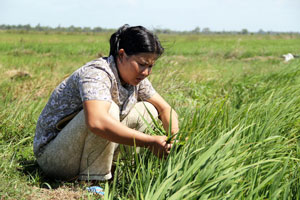A program funded by the Australian Government is helping Cambodian farmers increase the productivity of their land by improving local skills and infrastructure.
The Cambodia Agricultural Value Chain (CAVAC) program aims to help farmers increase production of rice and vegetables. So far, CAVAC has rehabilitated 20 irrigation schemes–repairing and building canals and ensuring that farmers can access them. Crop yields have increased and more plantings have become possible throughout the year.
Um Chanthy farms rice on three hectares of land in Prek Ressey village in Kampot province.
She has been growing rice for 15 years. Until recently, however, the farmers were forced to compete for a small amount of water from the local lake in order to irrigate their crops.
'Quite often the lake ran out of water since there were many farmers pumping like me,' Chanthy said.
'When the water ran out while the crops were still growing, I wouldn't get the full potential yield. Also, when there is not enough water, it is hard to control weeds because when the water doesn't cover the weeds fully, the weeds don't die.'
Now that CAVAC has rehabilitated the local Prey Tonle canal, Chanthy has a better water supply–increasing the number of rice crops she can grow each year and reducing the cost of pumping water to her fields.
Another woman whose fortunes have improved thanks to CAVAC is En Somaly, a single mother who grows rice on three hectares of land in Taphin village, Takeo province.
Until recently, Somaly could not farm as often as she would have liked. The only source of water during the dry season was a canal far away from her land, requiring multiple pumps to irrigate her paddy.
The CAVAC program rehabilitated the Kveng Tayi canal near Somaly's land in 2011. The canal is 5.14km long, and as a result of the rehabilitation, more than 1,000 farming households now have a reliable, year-round supply of water.
'With the new canal, the water source is closer to my rice fields. Now, I only have to use one pump connection, so I save about 30 litres of petrol per hectare per season,' Somaly said, adding that her crop yield increased at the same time.
'Before, I couldn't get water on time, so sometimes my rice plants were weak. With sufficient water in the rice fields, I can use more agricultural products such as fertiliser and pesticide to keep my rice growing well. In the past, I could get only 4.5 to 5 tonnes of rice per hectare. Now, I can get between 6 and 6.5 tonnes per hectare,' she said.
Somaly has also been using the new canal embankment as a road to get to the local market, enabling her to sell a wider variety of products at her shop. Others use the embankment to get to the local hospital and high school in Tunloap.
'This road gets us to those destinations much more quickly than the old road. On the old road, Tunloap was about 10 kilometres away, but via this embankment, the distance is about seven kilometres,' she said. 'Since the road is shorter and more convenient, I can also save petrol on transportation too.'

